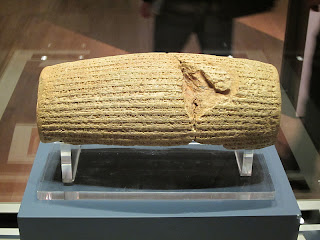It was a whirlwind going to the British Museum. I literally went around the world and back in time in a matter of hours. The museum is so large and collections so vast, it was literally to much to do in one day. I had to focus to areas of more interest to me (Greek, Egyptian, Roman, Medieval). There were artifacts and exhibits from every part of the world. All of it was so fascinating. Never would I ever seen the number of actual artifacts in one place. Nearly all of the stuff there is original, being taken from the country of origin and put in this museum. I know people who went to Greece. I assume they would go to the Acropolis, but they would not see the Acropolis pediment statues, whereas I did. I was in awe the whole time I am there. I took over 200 pictures to remember my experience. Seriously one of the best museums I have ever been to. Take note that I have not included many pictures of important artifacts (mainly Greek pottery). There were so many, so check out fb to see all of the pictures. Many of the things I saw I knew from my Ancient Art History class I took freshman year. I was excited to see the things in person.
British Museum: takes a lot from the Greek in terms of style
Inside the museum was inspiring. With grand staircases and soaring glass ceiling
This is a helmet (pieces) from the Sutton Hoo ship burial. The artifacts were found within a wooden (norse) vessel and is the earliest and richest burial ever found in Britain. Estimated early 600 AD. In the cases around this helmet were swords, shields and such from the site. I took particular interest in this type of artifact.
Reproduction of what the Sutton Hoo helmet looked like judging from the remains found
Mere clubs from Australia in the Enlightenment Room
Head of the winged lion. Assyrian(865-860 BC). The statues provided magical protection to the doorway to the throne room at the Palace of Ashurnasirpal II
The two lions protecting the doorway into the next exhibit
I admit that I did not go through the exhibits in a logical way. I just went room to room. Most similar subject and period stuff were in the same area and on different floors. I did one floor at a time then moved up to the next, so the pictures are jumbled.
Ramesses II
The Rosetta Stone...NBD. Key artifact to translating Egyptian Hieroglyphs.
Another pair of winged lion and ox leading into the Lion Hunt Assyrian Reliefs
The five legs could have meant that it was intended to be viewed from the front or side view, and not at this angle.
In ancient Assyria, lion-hunting was considered the sport of kings, symbolic of the ruling monarch. The following pictures depict sculpted reliefs (645-635 BC) of Ashurbanipal and were made for his palace at Nineveh. The hunt scenes are full of tension and realism, and rank among the finest achievements of Assyrian art. I remember looking at these for my Ancient Art History through Medieval class I took freshman year.
Ashurbanipal killing the lion
wounded and dying lions
Wounded lioness
Alexander the Great
The Erechtheum Caryatids (409 BC) : columns shaped as women and supported the roof of the Erechtheum.
The Nereid Monument (390-380 BC): largest and finest of the Lykian tombs and the first example of a temple tomb.
Suicide of Ajax
Cleopatra
Mummified animals, including CATS
Some medieval artifact
The photo's below are of the Lewis Chess set. In 1831, a remarkable hoard of carved walrus ivory was discovered on the Isle of Lewis in the Western Isles, Scotland. Researchers cannot determine why they were made or hidden. They don't show any use or wear. They are certainly northern in character and influenced by the Norse/vikings. "Of the 93 pieces known today, 11 are in Edinburgh at the National Museum of Scotland, and 82 are in the British Museum.
Icon painting of St. Peter
Necklaces called Torc (Celtic origin)
For those who know anything about Biblical history, the item above is the one and only Cyrus Cylinder (550-530 BC). Cyrus was the Persian king who allowed the Hebrew's to leave Egypt and rebuild their temple. This artifact is very significant to Christianity, and I was only inches from it.
Celtic swords with handles shaped like human shapes
Combined Wheelock and Matchlock Hand Mortar. A literal hand cannon that puts the Magnum to shame
Figures from the pediment of the Parthenon
The figures below are the figures that fit inside the triangular pediment at the parthenon. They are not even in Greece. I saw them...WOW
After my exhausting experience in the museum, I walked down the street to this shop that sells gentleman's canes (including cane swords) and umbrellas. Sadly it was not open on a sunday.
When I got back to the lovely home of the Dalton's, Barbara made me a traditional english dinner. Roast beef, potatoes, veggies, and Yorkshire Puddings. I was told at dinner that back in the day, the what little meat families could afford would be given to the working father, and the gravy made from the meat would be poured over the fluffy bread (yorkshire pudding) and given to the rest of the family. It was SO good. It was probably the best meal that I have had in my experience here. I defiantly want to bring back this recipe back home. I definitely ate my fill and it was good.




















































No comments:
Post a Comment